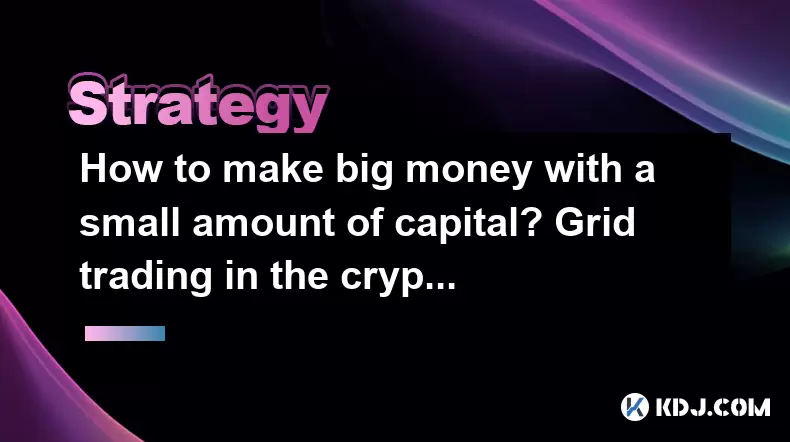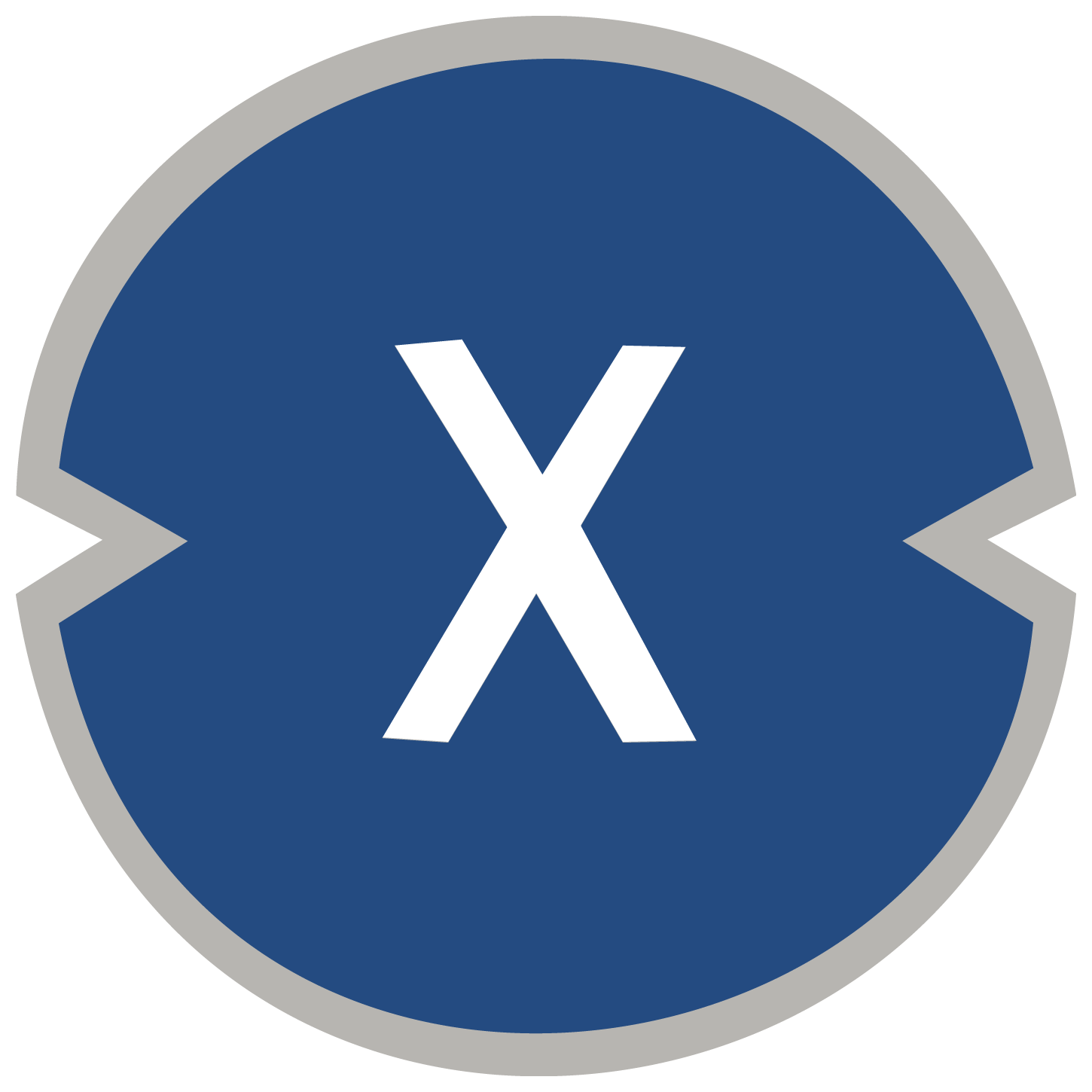-
 bitcoin
bitcoin $87959.907984 USD
1.34% -
 ethereum
ethereum $2920.497338 USD
3.04% -
 tether
tether $0.999775 USD
0.00% -
 xrp
xrp $2.237324 USD
8.12% -
 bnb
bnb $860.243768 USD
0.90% -
 solana
solana $138.089498 USD
5.43% -
 usd-coin
usd-coin $0.999807 USD
0.01% -
 tron
tron $0.272801 USD
-1.53% -
 dogecoin
dogecoin $0.150904 USD
2.96% -
 cardano
cardano $0.421635 USD
1.97% -
 hyperliquid
hyperliquid $32.152445 USD
2.23% -
 bitcoin-cash
bitcoin-cash $533.301069 USD
-1.94% -
 chainlink
chainlink $12.953417 USD
2.68% -
 unus-sed-leo
unus-sed-leo $9.535951 USD
0.73% -
 zcash
zcash $521.483386 USD
-2.87%
How to make big money with a small amount of capital? Grid trading in the cryptocurrency circle!
Grid trading lets you profit from crypto market swings with little capital by setting buy/sell orders at set price levels, automating trades on platforms like Binance.
Jun 02, 2025 at 01:22 am

Grid trading is a popular strategy within the cryptocurrency circle that allows traders to potentially make significant profits with a relatively small amount of capital. This method involves setting up a series of buy and sell orders at predetermined price levels, creating a 'grid' that aims to profit from market volatility. In this article, we will explore how you can leverage grid trading to maximize your returns, even with limited funds.
Understanding Grid Trading
Grid trading is a systematic approach to trading that doesn't require predicting market direction. Instead, it capitalizes on the natural fluctuations in price. The basic concept involves setting up a series of buy and sell orders at regular intervals within a specified price range. When the price moves up or down, these orders are triggered, allowing you to buy low and sell high within the grid.
To set up a grid, you need to define the upper and lower boundaries of your trading range, as well as the number of grids within that range. Each grid represents a price level at which you will place buy and sell orders. The distance between each grid is crucial, as it affects the frequency of trades and potential profits.
Setting Up a Grid Trading Strategy
To start grid trading, you will need to choose a reliable cryptocurrency exchange that supports this type of trading. Some popular exchanges that offer grid trading include Binance, Huobi, and OKEx. Once you have selected an exchange, follow these steps to set up your grid:
- Choose the trading pair: Select the cryptocurrency pair you wish to trade. Popular pairs include BTC/USDT, ETH/USDT, and others.
- Define the trading range: Determine the upper and lower price boundaries for your grid. This range should be based on your analysis of the market's volatility and expected price movements.
- Set the number of grids: Decide how many grids you want to set up within your trading range. More grids mean more frequent trades but also smaller profit margins per trade.
- Determine the grid spacing: Calculate the price interval between each grid. This will depend on the trading range and the number of grids you have chosen.
- Set the investment amount: Decide how much capital you want to allocate to your grid trading strategy. Remember, you can start with a small amount and scale up as you gain more experience.
Once you have set up your grid, the trading platform will automatically execute buy and sell orders when the price hits the predefined levels. This allows you to take advantage of market movements without constantly monitoring the market.
Advantages of Grid Trading
Grid trading offers several advantages for traders with limited capital. One of the main benefits is that it allows you to generate profits from both rising and falling markets. Since the strategy involves buying low and selling high within the grid, you can profit regardless of the overall market direction.
Another advantage is that grid trading can help you manage risk more effectively. By setting up a series of orders at different price levels, you can spread your risk across multiple trades. This can help mitigate the impact of any single trade going against you.
Additionally, grid trading can be an excellent way to automate your trading strategy. Once you have set up your grid, the trading platform will handle the execution of orders, freeing up your time to focus on other aspects of your trading strategy.
Potential Risks and Considerations
While grid trading can be a lucrative strategy, it is not without risks. One of the main risks is that the market may move outside of your predefined trading range. If this happens, your grid may not be triggered, and you could miss out on potential profits.
Another risk to consider is the impact of fees on your overall profitability. Since grid trading involves frequent buying and selling, the fees associated with these transactions can add up quickly. It's essential to choose an exchange with competitive fee structures to maximize your returns.
Finally, it's crucial to monitor your grid trading strategy regularly. While the strategy is automated, market conditions can change, and you may need to adjust your grid to adapt to these changes. Regular monitoring can help you optimize your strategy and minimize potential losses.
Optimizing Your Grid Trading Strategy
To maximize your profits with grid trading, it's essential to continually optimize your strategy. One way to do this is by adjusting your grid based on market volatility. If the market is experiencing high volatility, you may want to increase the number of grids to take advantage of more frequent price movements.
Another way to optimize your strategy is by adjusting the trading range. If the market is trending in a particular direction, you may want to shift your grid to capture more of the price movement. This can help you increase your potential profits while still maintaining a balanced risk-reward ratio.
It's also important to consider the impact of transaction fees on your overall profitability. To minimize the impact of fees, you may want to choose a trading pair with lower fees or adjust the number of grids to reduce the frequency of trades. By carefully managing your fees, you can increase your net profits over time.
Practical Example of Grid Trading
Let's walk through a practical example of how grid trading works. Suppose you decide to set up a grid trading strategy for the BTC/USDT pair on the Binance exchange. You choose a trading range of $30,000 to $35,000 and decide to set up 10 grids within this range. Each grid will be spaced at $500 intervals.
- Upper boundary: $35,000
- Lower boundary: $30,000
- Number of grids: 10
- Grid spacing: $500
You allocate $1,000 to your grid trading strategy. When the price of BTC/USDT reaches $30,000, your first buy order is triggered, and you purchase BTC at this price. As the price moves up, your subsequent buy orders are triggered at $30,500, $31,000, and so on.
When the price reaches $31,000, your first sell order is triggered, and you sell the BTC you purchased at $30,000 for a profit. As the price continues to move up, your subsequent sell orders are triggered at $31,500, $32,000, and so on.
By setting up this grid, you can profit from the price movements within the $30,000 to $35,000 range. If the price moves outside of this range, you can adjust your grid to capture new price movements and continue to generate profits.
Frequently Asked Questions
Q: Can I use grid trading on any cryptocurrency exchange?A: Not all cryptocurrency exchanges support grid trading. You will need to choose an exchange that offers this feature, such as Binance, Huobi, or OKEx. Always check the exchange's features before setting up your grid trading strategy.
Q: How much capital do I need to start grid trading?A: One of the advantages of grid trading is that you can start with a relatively small amount of capital. The exact amount will depend on the trading pair and the size of your grid, but many traders start with as little as $100 to $1,000.
Q: Is grid trading suitable for beginners?A: Grid trading can be suitable for beginners, but it's essential to understand the basics of the strategy and the risks involved. Start with a small amount of capital and practice on a demo account before trading with real money.
Q: How often should I monitor my grid trading strategy?A: While grid trading is automated, it's a good idea to monitor your strategy regularly. Check your grid at least once a day to ensure it is performing as expected and make any necessary adjustments based on market conditions.
Disclaimer:info@kdj.com
The information provided is not trading advice. kdj.com does not assume any responsibility for any investments made based on the information provided in this article. Cryptocurrencies are highly volatile and it is highly recommended that you invest with caution after thorough research!
If you believe that the content used on this website infringes your copyright, please contact us immediately (info@kdj.com) and we will delete it promptly.
- Navigating the Crypto Landscape: Identifying the Best Crypto to Buy Now for 2025 Success
- 2025-11-27 19:25:01
- Coinsilium's AGM: What's the Buzz?
- 2025-11-27 19:00:02
- Australia's Digital Asset Revolution: Decoding the Framework Bill 2025
- 2025-11-27 19:00:02
- Tether's Golden Ambition: How Private Gold Holdings Are Shaking Up the Market
- 2025-11-27 19:35:01
- Wallet Token Presale: Last Chance to Grab $BEST Before Listings!
- 2025-11-27 19:30:01
- Ripple's RLUSD Gets ADGM Approval: A Game Changer for Stablecoins in the Middle East
- 2025-11-27 19:35:01
Related knowledge

How to Bridge Your Crypto Assets: A Beginner's Guide to Cross-Chain Swaps.
Nov 21,2025 at 06:39pm
Understanding Cross-Chain Bridges in the Crypto Ecosystem1. Cross-chain bridges are protocols that allow users to transfer digital assets from one blo...

How to Backtest a Crypto Trading Strategy: A Guide to Data-Driven Decisions.
Nov 20,2025 at 12:40pm
Data Collection for Accurate Backtesting1. Historical price data forms the backbone of any crypto backtesting process. Reliable sources such as Binanc...

A Guide to Trading Altcoin Seasons: How to Maximize Your Gains.
Nov 16,2025 at 11:00pm
Understanding Altcoin Seasons1. An altcoin season refers to a market phase where alternative cryptocurrencies outperform Bitcoin in terms of price gro...

How to Lend Your Crypto: A Simple Guide to Earning Interest.
Nov 18,2025 at 01:19am
Lending Crypto: Understanding the Basics1. Cryptocurrency lending allows users to earn interest by providing their digital assets to borrowers through...

The Beginner's Guide to Decentralized Exchanges (DEX): Trading with Control.
Nov 16,2025 at 05:20pm
The Beginner's Guide to Decentralized Exchanges (DEX): Trading with Control Decentralized exchanges, commonly known as DEXs, are transforming the way ...

How to Use Fibonacci Retracement in Crypto: A Guide for Technical Traders.
Nov 20,2025 at 01:39am
Understanding Fibonacci Retracement in the Context of Cryptocurrency Trading1. Fibonacci retracement is a popular technical analysis tool derived from...

How to Bridge Your Crypto Assets: A Beginner's Guide to Cross-Chain Swaps.
Nov 21,2025 at 06:39pm
Understanding Cross-Chain Bridges in the Crypto Ecosystem1. Cross-chain bridges are protocols that allow users to transfer digital assets from one blo...

How to Backtest a Crypto Trading Strategy: A Guide to Data-Driven Decisions.
Nov 20,2025 at 12:40pm
Data Collection for Accurate Backtesting1. Historical price data forms the backbone of any crypto backtesting process. Reliable sources such as Binanc...

A Guide to Trading Altcoin Seasons: How to Maximize Your Gains.
Nov 16,2025 at 11:00pm
Understanding Altcoin Seasons1. An altcoin season refers to a market phase where alternative cryptocurrencies outperform Bitcoin in terms of price gro...

How to Lend Your Crypto: A Simple Guide to Earning Interest.
Nov 18,2025 at 01:19am
Lending Crypto: Understanding the Basics1. Cryptocurrency lending allows users to earn interest by providing their digital assets to borrowers through...

The Beginner's Guide to Decentralized Exchanges (DEX): Trading with Control.
Nov 16,2025 at 05:20pm
The Beginner's Guide to Decentralized Exchanges (DEX): Trading with Control Decentralized exchanges, commonly known as DEXs, are transforming the way ...

How to Use Fibonacci Retracement in Crypto: A Guide for Technical Traders.
Nov 20,2025 at 01:39am
Understanding Fibonacci Retracement in the Context of Cryptocurrency Trading1. Fibonacci retracement is a popular technical analysis tool derived from...
See all articles










































































